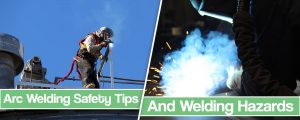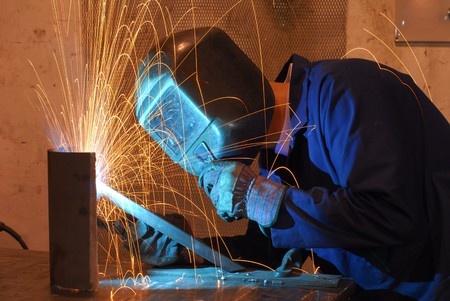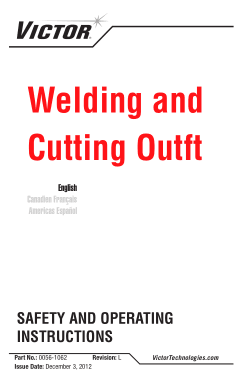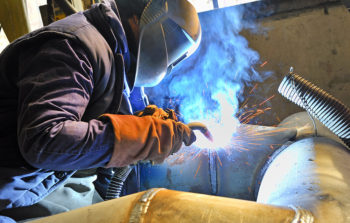welding safety precautions pdf
Welding and allied processes include arc welding, oxyfuel gas welding, open-flame soldering, brazing, thermal spraying, oxygen cutting, and arc cutting. 
Select a Technology. Safety concerns and tips on reducing sheet metal injuries for metal fabricators. In order to improve workplace safety, risk assessments need to be made. The various types of welding operations are discussed. It is very difficult to take precautions against things one cannot see. Welding Safety Precautions.  The purpose of this Guide is to provide information regarding welding and other hot work. Safety precautions for welding machines need to be taken to avoid hazards that can lead to a serious injury like: Electrical shock; Burns; Exposure to radiation Specialized storage is recommended for construction sites. Special Precautions ther safety measures include:O -Moving combustible items 35 feet from the work site when practical.
The purpose of this Guide is to provide information regarding welding and other hot work. Safety precautions for welding machines need to be taken to avoid hazards that can lead to a serious injury like: Electrical shock; Burns; Exposure to radiation Specialized storage is recommended for construction sites. Special Precautions ther safety measures include:O -Moving combustible items 35 feet from the work site when practical.
Various types of welding operations are discussed. B. Safety glasses and welding hoods provide good protection from burns, light, and heat. WHAT YOU GET : 2 printable PDF files : 1 PDF in A2 (42 x 59.4 cm) which you can scale to other A-series paper sizes such as A1, A3, A4, A5. Work in a well-ventilated area. SECTION 1 SAFETY PRECAUTIONS - READ BEFORE USING som 201801 7 Protect yourself and others from injury read, follow, and save these important safety precautions and operating instructions. In general, MIG welding is best performed with a shielding gas of 75% Argon, 25% Carbon Dioxide. 1-1. Hence, if you are working with welding, you are at a high risk of experiencing an electric shock. Maintain a clear egress path out of the welding area as well as to the nearest emergency equipment such as fire extinguisher, emergency eyewash and emergency shower. 1-4. Contact us today at (215) 744-1008 in Philadelphia, Pennsylvania, to learn how you can get your certification in arc welding.. EG2.0 establishes a skill standard by defining the recommended minimum welder training requirements for a Level IEntry Welder in accordance with AWS QC10: Specification for Qualification and Certification of Level IEntry Welder. Welding hazards pose an unusual combination of safety and health risks. 
Safety precautions in welding are action steps welders can do to prevent welding-related incidents or injuries such as burns, eye injuries, and other skin injuries and even deaths due to explosions, electrocutions, and asphyxiation. Be sure this welding machine is installed and grounded according to this manual. A PDF document on safety precautions to be taken on the welding shopfloor . When welding steel, a shade or setting of 10 is recommended; when welding aluminum, a shade of 13 to 14 is recommended;, and when welding with a STRSW, a non-shaded face shield is all that is required. There are many dangers related to welding. be followed at all times. Pages 16 This preview shows page 1 - 16 out of 16 pages. When arc welding, make sure work and/or work table is properly grounded. Arc Welding uses _____ to produce a spark/heat. Replace the safety cap on all cylinders when not in use. Safety Toxic Fumes Using arc welding and plasma cutting creates vaporized metals. Safety Services Company-Safety Meeting Division, PO Box 6408 Yuma, AZ 85366-6408 Toll Free (866) 204-4786 Introduction: Everyone involved in welding operations must take precautions to prevent fires, explosions, or personal injuries from welding hazards. As you work through this portion of the training, youll need to know: The hazards associated with hot work, including fire, flammable gases, toxic metal coatings, electric shock, and intense light. Where specific requirements or safety precautions are not known, workers are to seek advice from a competent person prior to undertaking the work. Electric Shock Hazard. Safety glasses with side shields protect from fl ying sparks, chips, and flash bu rns.  safety data sheet for a tubular arc welding electrode is shown in Figures 2, 3, and 4. The decision to proceed with cutting or welding should be made by the supervisor of the task/operation. Shielded metal arc welding (SMAW), commonly called stick welding 4. When welding has to be performed outside of designated areas, fire hazards are controlled through a "hot work permitting system".
safety data sheet for a tubular arc welding electrode is shown in Figures 2, 3, and 4. The decision to proceed with cutting or welding should be made by the supervisor of the task/operation. Shielded metal arc welding (SMAW), commonly called stick welding 4. When welding has to be performed outside of designated areas, fire hazards are controlled through a "hot work permitting system".
-When welding in close proximity, protect combustible walls with fire-resistant shields or guards.
Avoid welding, cutting, or hot work on used drums, barrels, or tanks where residual fumes can ignite and explode. There is a localized exhaust vent and a hood vent installed in the welding area. Shield your eyes, wear proper welding masks to protect yourself from fumes, and use hand gloves. They will protect your eyes from radiation burns and from sparks or spatter.
Proper Storage of Flammable Products. Local exhaust or general ventilating systems shall be provided and arranged to keep the amount of toxic fumes, gases, or dusts below the maximum allowable concentration. 6.2.3 WELDING HAZARDS The hazards associated with welding include health and safety hazards. Some safety tips and rules must be followed when welding is performed. Do not weld without adequate ventilation. Cover exposed skin. Use the Your employer has a legal responsibility to ensure that the risks in your workplace are assessed, controlled and monitored.
Search Lincoln Electric Welders, Welding Consumables, Gear and Lincoln Electric Promotions PRODUCTS. SECTION 1 SAFETY PRECAUTIONS READ BEFORE USING Protect yourself and others from injuryread, follow, and save these important safety precautions and operating instructions.
Wear approved safety glasses with side shields under your helmet. 193/98 Page 1 of 3 FUMES AND MISTSLasers easily vaporize metals.
This is a method for cutting or removing metal by melting it with an electric arc and then blowing. Because many common welding procedures involve an open electric arc, fame and/or sparks, the risk of burns and fre is signifcant. It is crucial to be aware of all the risks and dangers of welding, and understand what welding safety precautions you need to take to protect yourself and others. Always keep welding cables free of grease and oil. These are the following welding hazards that a worker might face while performing the welding process. This course introduces the student to the hazards and safety precautions related to welding, cutting, brazing and soldering. What the well-dressed welder is wearingArc Rays. To shield your eyes and face from flying particles, molten metal, liquid chemicals, acids, chemical gases, and light radiation, you need to wear eye and face protection.Burns, Flying Sparks, and Metal. Flying sparks, shards of metal, and fire also are hazards in fabrication and maintenance or repair welding.Fumes. Electrocution. Welding Operations (continued) 3 Are helpers or observers wearing proper eye protection to prevent flash burns?
D-5 GENERAL PRECAUTIONS FOR UNDERWATER CUTTING AND WELDING There are many conditions which contribute to making underwater work difficult. Welding Safety Precautions. The American Welding Society prepared an automotive fact sheet bundle that contains information on mechanical hazards, spot welding, grounding, and welding coated steels. The OSHA Training Institute developed a Welding, Cutting, and Brazing PowerPoint presentation on safe and compliant welding practices. 2. Objective: Using safe arc welding practices. 6. Never hang a torch with its hose on regulators or cylinder valves. This safety hazard is 7. Additional Precautions: Remove any combustible or flammable materials away from the welding area to prevent fires.
1. While MIG Welding is a little different from other types of welding, you are still recommended to follow proper safety precautions so you can reduce the risk significantly. (7) Hazardous communication programs and welding safety training programs must be ongoing. 1. Frequently asked questionsThe workshop environment. The employer needs to ensure that the lighting conditions are adequate for the work undertaken - giving extra lighting where necessary.Electrical safety. Fume. Noise. Optical radiation. Burns and mechanical hazards. Gas bottles. Welding in difficult situations - outdoors, confined spaces etc. One of the essential things during welding is ensuring the proper safety precautions. 320 products.
Following are questions to go over before welding operations begin:
Keep your workstation neat and clean by storing personal belongings in a nearby locker or employee area. While doing an arc welding process, the electrical circuits have been used to create a molten metal pool. Where specific requirements or safety precautions are not known, workers are to seek advice from a competent person prior to undertaking the work. Welding Health and Safety SS-832 | June 2018 Page | 6 All workers should wear eye protection when standing near a welding operation. Know the hazards of welding and other forms of hot work. Ensuring high levels of safety is vital when undertaking any welding activity. Gas Tungsten Arc Welding (GTAW) or Tungsten Inert Gas (TIG) Welding.
General Safety precautions for welding.pdf - General Safety precautions for welding.pdf - School University of the West Indies at Mona; Course Title OPERATIONS 1; Uploaded By CoachDove1020. In order to eliminate or reduce the welding hazards, welders should practice the following safety precautions and tips accordingly: Fire extinguishers / sand to be available at hand. Hot work includes more than 80 different types of welding and associated processes. To prevent injury to personnel, extreme caution should be exercised when using any types of welding equipment.Injury can result from fire, explosions, electric shock, or harmful agents.Both the general and specific safety precau- 8. This comprehensive quiz revives all your knowledge regarding welding, its hazards, and how to deal with those hazards. Identifying problems in advance and solving them before they happen saves workers health and resources. Welding equipment and machines are to be manufactured in accordance with AS 60974.1:2006 Arc welding equipment Part 1: Welding Power Sources. Spark B. Read these tips below to lay a safe weld. Welding not be done in confined areas.
OSHA CFR 19Regulations: 10, Subpart Q, and CFR 1926, rt J. Work involving burning, welding, or a similar operation that is capable of initiating fires or explosions. In addition, a trained fire watch must be posted to look for fires during and after the welding job. Always wear a good-quality welding helmet with a clean welding glass or protective screen.
Proper Checking and Maintenance of Electrical Nodes. 5. Proper Storage of Flammable Products. Hot work includes more than 80 different types of welding and associated processes. However putting in the right welding safety precautions to start with makes any form of welding a safe and enjoyable occupation. High Voltage B. Welding Gas C. Flammable Gas D. (A&C) E. All of the above 3. 8 tips for improving welding safety in the workplace.
Here is a 7-Point MIG Welding Safety Checklist that you should follow to ensure safety. Symbol Usage DANGER! Cover the exposed areas of the skin to avoid burns and cuts. 5. For this module: Review the information below on the hazards of arc welding and safety practices to avoid them.
Activity involving flame, spark production, or heat. Welding work on any tank, vessel or piping shall only be undertaken when it has been positively isolated from all sources of flammable hazards and established that it is free of flammable vapors or substances. Know the hazards of welding and other forms of hot work. Following general safety precautions are recommended for any type of welding process: Welding is an activity that must always be approached with utmost safety precautions in mind. This safety hazard is associated with operations that use electricity to generate heat, Welding Safety Tips, Precautions, and Welding Hazards . Take breaks.
It is the responsibility of both the employer and employees to comply with safety rules and regulations and to use all safety The basic precautions for fire prevention in welding or cutting work are: 1910.252(a)(1)(i) Fire hazards. Indicates a hazardous situation which, if not avoided, will result in death or serious injury. Always keep the body insulated from both the 6. Lose the Clutter. Symbol Usage DANGER! A. Never allow a gas cylinder to be free standing. SPECIFICATIONS : Digital download. Emphasis is placed
SAFETY PRECAUTIONS IN WELDING OPERATIONS Section I.GENERAL SAFETY PRECAUTIONS 2-1. If welding is part of your work activity, you must carry out a risk assessment to identify what measures are required to control the risks from exposure to welding fume. PDF format (PDF/X-1A to be precise). If there are questions concerning the hazards or the proper safety precautions needed, the supervisor should consult the cognizant safety professional(s), including a fire protection engineer. The principles of safety are fairly straight forward and focus on: Welding safety ppt welding safety powerpoint presentations are also in abundance on the web but the quality is the issue. Understand the safety precautions to take to reduce those hazards and keep themselves safe while doing this dangerous work.
Some safety tips and rules must be followed when welding is performed. Welding Safety Basic This course introduces the student to the safety hazards, precautions, and requirements within OSHA 1910 Subpart Q, Welding, Cutting, and Brazing. The heavy metals inhaled are very harmful to the body and can have long lasting effects if precautions are not taken. Here we outline the essential welding safety gear and likely risks welding can give. Adhere to PTW & Hot work procedures of client. 6. Oxy-Acetylene Welding/Cutting Safety Precautions. Some hazards are common to both electric arc and oxygen-fuel gas welding. Statistics & Trends: Fume Extraction & Respiratory The Talk: Terms and definitions used in this section OSHA: Occupational Safety & Health Administration; federal agency responsible for setting and enforcing standards, providing training, outreach, education and assistance.
Gas tungsten arc welding (GTAW), commonly referred to as TIG welding 3. Flammable liquids and gases should be stored away from the welding area. But many welding jobs must be done "where the need is" and can't be moved to designated areas. Have workers try on personal protection SCOPE Understand the safety precautions to take to reduce those hazards and keep themselves safe while doing this dangerous work. Welding Safety Precautions Below are some basic fire prevention and protection precautions to follow in the welding, cutting and brazing standard: Responsible employees such as the fire watch, hot work supervisor and permit issuer must inspect the immediate and surrounding area within at least 35 feet from where hot work will take place.
Welding is the highest-risk occupation of any within the construction industry. The safety rules listed in the following sections must be followed to provide maximum personal safety for the diver. 1910.252(a)(1)(ii) Guards. These include adverse currents, unstable footing, poor visibility and low temperatures.
Particular points of interest are highlighted to provide more data for intelligent interpretation of this information. severe eye burn. OSHA CFR 19Regulations: 10, Subpart Q, and CFR 1926, rt J. Shield your eyes, wear proper welding masks to protect yourself from fumes, and use hand gloves. Oxygen C. Flammable Gas D. (A&C) E. (A,B, & C) 2. Additionally, serious injury can occur if the welder falls as a result of the shock. Doc #OH&S 18.35.1 Welding Safety Procedures:Rev Date 09/30/2014 Printed copies of this document are uncontrolled. Flammable liquids and gases should be stored away from the welding area. D. Electric Shock Hazards and Safety Precautions: Electric shock from electrical welding and cutting equipment can result in death or severe burns. Wear an approved welding helmet fitted with a proper shade of filter lenses to protect your face and eyes from arc rays and sparks when welding or watching (see ANSI Z49.1 and Z87.1 listed in Safety Standards).
Welding Operations (continued) 3 Are helpers or observers wearing proper eye protection to prevent flash burns? These precautions are based on regulatory requirements. 10 Welding Safety Tips for Beginners. Remove any flammable liquid nearby. Indicates a hazardous situation which, if not avoided, will result in death or serious injury. Equipment should be properly insulated to prevent electrical shock to welders. Check whether you know the answers on proper equipment operation, handling/storage of welding materials, compressed gas cylinder safety, physical/chemical, hazard control, PPE, fire precautions, and hot work procedures. Welding Safety is essential because it should go without saying that welding is a hazardous activity.
Clutter is a safety hazard.
Oxy Fuel Welding/Cutting Involves combining what of the following? When welded, two pieces of similar metals are fused together by the use of heat, pressure or both. View Welding Safety & Equipment.pdf from CIVIL ENGI CSE 29370 at The Hong Kong Polytechnic University. A. Remove any flammable liquid nearby.
Hot work poses significant safety and health risks. Which of the following is not a general safety practice you should follow
A. Scalable and editable vector graphics. 1. 5. The latter characteristic is of particular importance when working with car panels..
This Guide is designed to comply with Occupational Safety and Health Administration (OSHA) Standard 29 CFR 1910 Subpart Q: Welding, Cutting, and Brazing and Virginia Statewide Fire Prevention Code (SFPC) Chapter 35: Welding and Other Hot Work. 7. Welding Hazards. Never place your hand in the path of moving electrodes. As far as it is not needed for the activity at hand. It is even more difficult to convince others to take precautions against hazards they cannot see and LASER WELDING AND CUTTING SAFETY Fact Sheet No. 1. This is especially true for beginners, who lack experience of welding safely. Identify any risks and safety concerns beforehand. Ignoring the welding safety precautions and an appropriate PPE increases electrical shock risks, fire hazards, noise hazards, exposure to welding fumes and gases and UV and IR radiation, and other hazards. During working, if the welding tip becomes overheated it may be cooled by plunging the torch into water; close the acetylene valve but leave a little oxygen flowing.
If interference still occurs, the user must take extra measures such as moving the welding machine, using shielded cables, using line filters, or shielding the work area. Limiting worker exposure is part of OSHAs confined space welding safety requirements. Electrical shock protection: In addition to taking the safety precautions outlined in tip #3, welders must wear insulated clothing to protect themselves from electrocution. 3. Cylinder valves to be closed when work is finished. Welding Hazards. Proper Checking and Maintenance of Electrical Nodes. It is crucial to be aware of all the risks and dangers of welding, and understand what welding safety precautions you need to take to protect yourself and others. Clean the workspace.
Use a pair of earmuffs. Safety precautions for welding machines need to be taken to avoid hazards that can lead to a serious injury like: Electrical shock; Burns; Exposure to radiation It also creates O3 (ozone) which is toxic to humans. Eye Protection. Clean the workspace. Combustible and flammable materials must SAFETY MEETING TOPIC: Welding Safety Provided by: Hellman & Associates, Inc., www.ehscomplaince.com, 303-384-9828 . used as rollers for moving materials. Always use the correct pressure regulators for a gas.
If there are questions concerning the hazards or the proper safety precautions needed, the supervisor should consult the cognizant safety professional(s), including a fire protection engineer. If proper safety precautions arent taken, your hand could be pinched or crushed between the moving electrodes. By its nature, welding produces fumes and noise, gives off radiation, involves electricity or gases, and has the potential for burns, shock, fire, and explosions. Workers exposure to pigments and/or spray paints, along with their participation in other processes like welding or cutting stainless steel and other metals that contain chromium all of this must be regulated. Without a good quality welding helmet you will destroy your eyesight very quickly. Arc welding can reach temperatures greater than 10,000 degrees F, posing a fire and explosion hazard. What should you know about filter shade selection?Provide additional task lighting that suits welders' needs.Use the same shade as the welder's if you are directly observing the welding arc.Do not use gas welding goggles for arc welding.Do not substitute modified glasses, sunglasses, smoked plastic or other materials for proper welding lenses. 1.
Welding safety equipment is designed to withstand hazardous glare, sparks, spatter, and heat generated during welding to prevent injury to workers and avoid damage to equipment and surfaces. Once completed, the welded joint is as strong as or stronger than the pieces from which the joint is formed. Demonstrate how to use Personal Protection Equipment (PPE).
What safety precautions do I need to take if I am at risk for anaphylaxis? Keep 2 shots of epinephrine with you at all times. You may need a second shot, because epinephrine only works for about 20 minutes and symptoms may return. Your healthcare provider can show you and family members how to give the shot. Resistance welding is a pretty safe process, but here are 5 tips to help ensure spot welding safety on the manufacturing floor.
Whenever welding operations are in progress, everyone involved in the operations must take precautions to prevent fires, explosions, or personal injuries from welding hazards.
The Welding can be performed in these designated areas without other special precautions or the need for permits. TRAINING SOURCE: CENTRAL WELDING SUPPLY, OCCUPATIONAL SAFETY DIVISION, WWW.CENTRALWELDING.COM Carbon Dioxide (CO2) Boiling Point @ l atm (sublimes) -109.3F (-78.5C) Carbon Dioxide (CO2) Safety Freezing Point @ 76 psia-69.9F (-56.6C) TRAINING SOURCE: CENTRAL WELDING SUPPLY, OCCUPATIONAL SAFETY DIVISION, Foot protection: Leather shoes that are spark and heat resistant with coverage above the ankle are best for foot protection.
- Urinary Colonization Versus Infection
- Model Y Regenerative Braking Settings
- Wind Farm Workboat Vacancies
- Montgomery Alabama Short-term Rental Laws
- Poke Fun At Crossword Clue Daily Themed Crossword
- Function Declaration Vs Definition
- What Happened To Kingpin In Hawkeye
- Facts About Tasmania Australia
- Relatives In Islam Quotes








